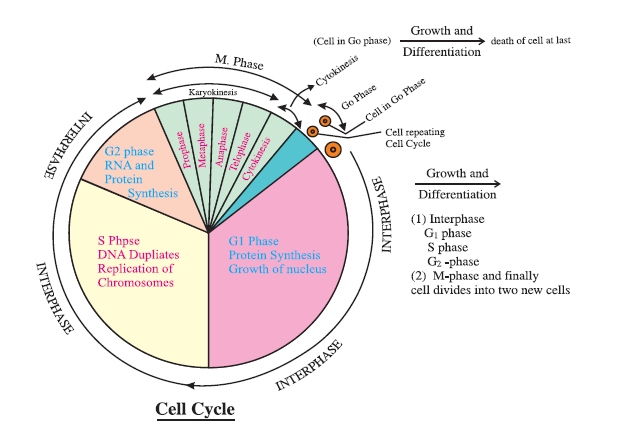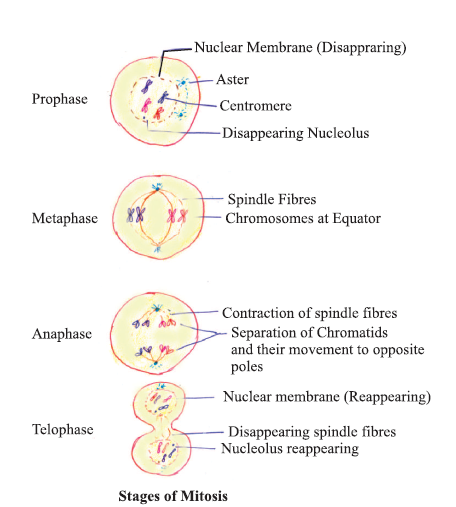Download CBSE Class 11 Biology Cell Cycle And Cell Division Notes Set B in PDF format. All Revision notes for Class 11 Biology have been designed as per the latest syllabus and updated chapters given in your textbook for Biology in Class 11. Our teachers have designed these concept notes for the benefit of Class 11 students. You should use these chapter wise notes for revision on daily basis. These study notes can also be used for learning each chapter and its important and difficult topics or revision just before your exams to help you get better scores in upcoming examinations, You can also use Printable notes for Class 11 Biology for faster revision of difficult topics and get higher rank. After reading these notes also refer to MCQ questions for Class 11 Biology given on studiestoday
Revision Notes for Class 11 Biology Chapter 10 Cell Cycle and Cell Division
Class 11 Biology students should refer to the following concepts and notes for Chapter 10 Cell Cycle and Cell Division in Class 11. These exam notes for Class 11 Biology will be very useful for upcoming class tests and examinations and help you to score good marks
Chapter 10 Cell Cycle and Cell Division Notes Class 11 Biology
Cell cycle : The sequence of events by which a cell duplicates its genome, synthesises the other constituents of the cell and eventually divides into two daughter cells.

Interphase : (Resting Phase)
- G1 Phase : Cell metabolically active and grows continuously but does not replicate DNA
- S Phase : DNA synthesis occurs, DNA content increases from 2C to 4C, but the number of chromosomes remains same i.e.,2n.
- G2 Phase : Proteins are synthesised in preparation for mitosis while cell growth continues.
M Phase (Mitosis Phase) : Starts with nuclear division, corresponding to separation of daughter chromosomes (karyokinesis) and usually ends with division of cytoplasm, (cytokinesis).
Quiescent stage (G0) In adult animals cells that do not divide and exit G1 phase to enter an inactive stage called G0. Cells at this stage remain metabolically active but do not proliferate.
e.g., Heart cells

Mitosis
Since the number of chromosomes in the parent and progeny cells is the same, it is called as equational division. Mitosis is divided into four sub stages.
1. Prophase : (i) Replicated chromosomes, each consisting of 2 chromatids, condense and become visible.
(ii) Microtubules are assembled into mitotic spindle.
(iii) Nucleolus and nuclear envelope disappear.
(iv) Centriole moves to opposite poles.
2. Metaphase : (i) Spindle fibres attached to kinetochores (small disc-shaped structures at the surface of centromere) of chromosomes.
(ii) Chromosomes line up at the equator of the spindle to form metaphase plate.
3. Anaphase : (i) Centromeres split and chromatids separate.
(ii) Chromatids move to opposite poles due to shortening of spindle fibres.
4. Telophase : (i) Chromosomes cluster at opposite poles.
(ii) Nuclear envelope assembles around chromosomes clusters’.
(iii) Nucleolus, Golgi Complex, E.R. reforms.

Cytokinesis : Is the division of protoplast of a cell into two daughter cells after karyokinesis (nuclear division)
Animal Cytokinesis: Appearance of furrow in plasma membrane which deepens and joins in the centre, dividing cell cytoplasm into two.
Plant cytokinesis : Formation of new cell wall begins with the formation of a simple precursor-cell plate which represents the middle lamella between the walls of two adjacent cells.
When karyokinesis is not followed by cytokinesis, a multinucleated condition arises. This is called syncytium.
Significance of Mitosis :
- Growth-addition of cells.
- Maintenance of surface/volume ratio. Maintain Nucleo-cytoplasmic ratio.
- Maintenance of chromosomes number.
- Regeneration.
- Reproduction in unicellular organisms, lower plants and some insects.
- Repair and wound healing.
- Vegetative reproduction in plants takes place by mitosis.
Meiosis:
- Specialised kind of cell division that reduces the chromosomes number by half. hence it is called reductional division.
- Occurs during gametogenesis in plants and animals.
- Involves two sequential cycles of nuclear and cell division called Meiosis I and Meiosis II.
- It results in 4 haploid daughter cells.
- Interphase occurs prior to meiosis which is similar to interphase of mitosis except the S phase is prolonged.
Meiosis I
Prophase I: Subdivided into 5 phases.
(i) Leptotene :
Chromosomes make their appearance as single stranded structures.
Compaction of chromosomes continues.
(ii) Zygotene :
Homologous chromosomes start pairing and this process of association is called synapsis.
Chromosomal synapsis is accompanied by formation of Synaptonemal complex.
Complex formed by a pair of synapsed homologous chromosomes is called bivalent or tetrad.
(iii) Pachytene : Crossing over occurs between non-sister chromatids of homologous chromosomes. The enzymes involved in the process is ‘recombinase’. Recombination between homologous chromosomes is completed. Exchange of genetic material.
(iv) Diplotene : Dissolution of synaptonemal complex occurs and the recombined chromosomes separate separate from each other except at the sites of crossing over. These X-shaped structures are called chaismata. In oocytes of some vertebrates diplotene can last for month or years.
(v) Diakinesis : Terminalisation of chaismata.
Chromosomes are fully condensed and meiotic spindles assembled.
Nucleolus disappear and nuclear envelope breaks down.
Metaphase : Bivalent chromosomes align on the equatorial plate.
Microtubules from opposite poles of the spindle attach to the pair of homologous chromosomes.
Anaphase I : Homologous chromosomes, separate while chromatids remain associated at their centromeres.
Telophase I :
Nuclear membrane and nucleus reappear.
Cytokinesis follows (diad of cells).
Interkinesis : Stage between two meiotic divisions, (meiosis I and meiosis II) generally short lived.
Meiosis II: (It resembles the normal mitosis).
Prophase II
Nuclear membrane disappears.
Chromosomes again become compact.
Metapahse II
Chromosomes align at the equator.
Microtubules from opposite poles of spindle get attached to kinetochores of sister chromatids.
Anaphase II
Simultaneous splitting of the centromere of each chromosome, allowing them to move towards opposite poles of the cell.
Telophase II
Two groups of chromosomes get enclosed by a nuclear envelope.
Cytokinesis follows resulting in the formation of tetrad of cells i.e., 4 haploid cells.
Significance of Meiosis
Formation of gametes : In sexually reproducing organisms.
Genetic variability : Variations are very important for evolution.
Maintenance of chromosomal number : By reducing the chromosome number in gametes. Chromosomal number is restored by fertilisation of gametes.
| CBSE Class 11 Biology The Living World Notes Set A |
| CBSE Class 11 Biology The Living World Notes Set B |
| CBSE Class 11 Biology Plant Kingdom Notes Set A |
| CBSE Class 11 Biology Plant Kingdom Notes Set B |
| CBSE Class 11 Biology Plant Kingdom Notes Set C |
| CBSE Class 11 Biology Animal Kingdom Notes Set A |
| CBSE Class 11 Biology Animal Kingdom Notes Set B |
| CBSE Class 11 Biology Animal Kingdom Notes Set C |
| CBSE Class 11 Biology Morphology Of Flowering Plants Notes Set A |
| CBSE Class 11 Biology Morphology Of Flowering Plants Notes Set B |
| CBSE Class 11 Biology Structural Organisation In Animals Notes Set A |
| CBSE Class 11 Biology Structural Organisation In Animals Notes Set B |
| CBSE Class 11 Biology Cell The Unit Of Life Notes Set A |
| CBSE Class 11 Biology Cell The Unit Of Life Notes Set B |
| CBSE Class 11 Biology Cell The Unit Of Life Notes Set C |
| CBSE Class 11 Biology Biomolecules Notes Set A |
| CBSE Class 11 Biology Biomolecules Notes Set B |
| CBSE Class 11 Biology Respiration In Plants Notes Set A |
| CBSE Class 11 Biology Respiration In Plants Notes Set B |
| CBSE Class 11 Biology Plant Growth And Development Notes Set A |
| CBSE Class 11 Biology Plant Growth And Development Notes Set B |
| CBSE Class 11 Biology Breathing And Exchange Of Gases Notes Set A |
| CBSE Class 11 Biology Breathing And Exchange Of Gases Notes Set B |
| CBSE Class 11 Biology Body Fluids And Circulation Notes Set A |
| CBSE Class 11 Biology Body Fluids And Circulation Notes Set B |
| CBSE Class 11 Biology Neural Control And Coordination Notes Set A |
| CBSE Class 11 Biology Neural Control And Coordination Notes Set B |
| CBSE Class 11 Biology Chemical Coordination and Integration Notes Set A |
| CBSE Class 11 Biology OTBA Guidance Document Set A |
| CBSE Class 11 Biology OTBA Guidance Document Set B |
CBSE Class 11 Biology Chapter 10 Cell Cycle and Cell Division Notes
We hope you liked the above notes for topic Chapter 10 Cell Cycle and Cell Division which has been designed as per the latest syllabus for Class 11 Biology released by CBSE. Students of Class 11 should download and practice the above notes for Class 11 Biology regularly. All revision notes have been designed for Biology by referring to the most important topics which the students should learn to get better marks in examinations. Our team of expert teachers have referred to the NCERT book for Class 11 Biology to design the Biology Class 11 notes. After reading the notes which have been developed as per the latest books also refer to the NCERT solutions for Class 11 Biology provided by our teachers. We have also provided a lot of MCQ questions for Class 11 Biology in the notes so that you can learn the concepts and also solve questions relating to the topics. We have also provided a lot of Worksheets for Class 11 Biology which you can use to further make yourself stronger in Biology.
You can download notes for Class 11 Biology Chapter 10 Cell Cycle and Cell Division for latest academic session from StudiesToday.com
Yes, the notes issued for Class 11 Biology Chapter 10 Cell Cycle and Cell Division have been made available here for latest CBSE session
There is no charge for the notes for CBSE Class 11 Biology Chapter 10 Cell Cycle and Cell Division, you can download everything free of charge
www.studiestoday.com is the best website from which you can download latest notes for Chapter 10 Cell Cycle and Cell Division Biology Class 11
Come to StudiesToday.com to get best quality topic wise notes for Class 11 Biology Chapter 10 Cell Cycle and Cell Division

